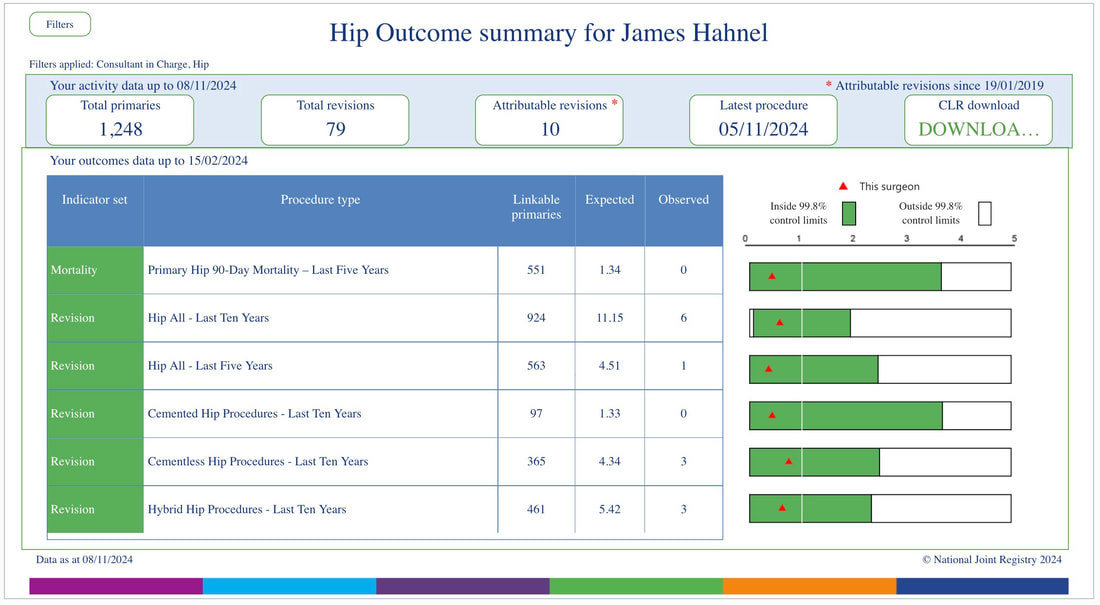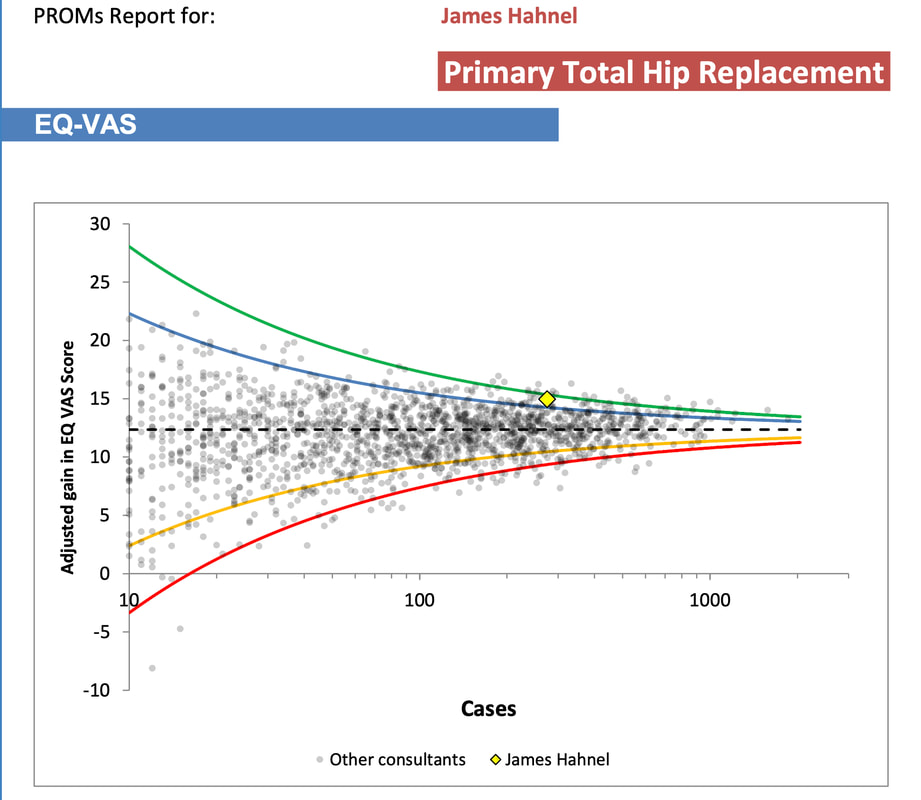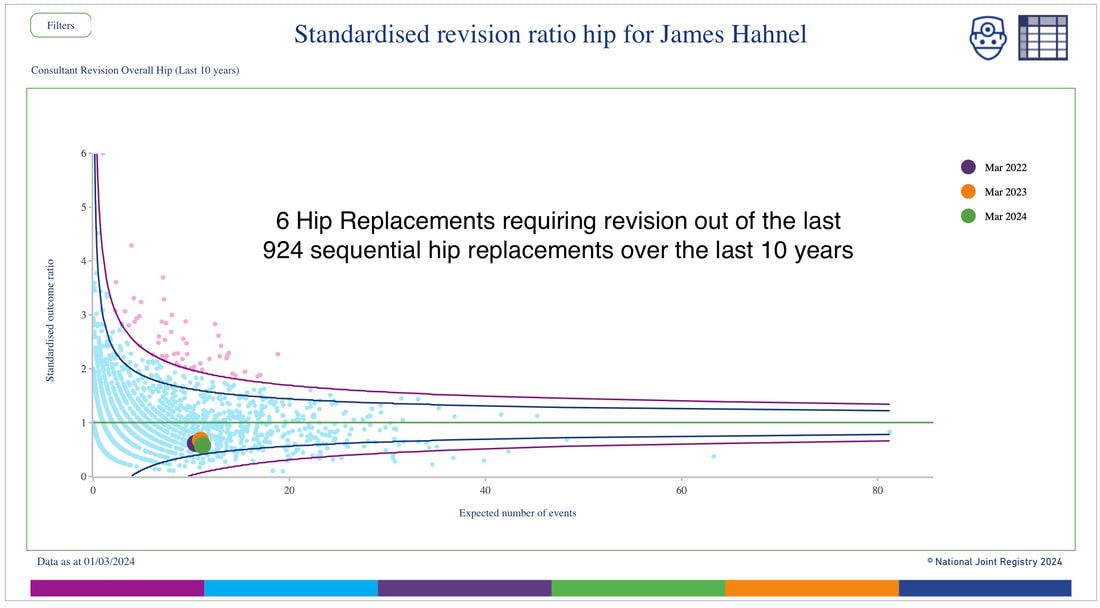Why choose James for hip surgery?
James Hahnel has performed well in excess of a thousand hip replacements and has been a Consultant orthopaedic surgeon since 2011. He works in the NHS performing hip and knee replacements as well as looking after sports injuries (including knee arthroscopy). He is a NHS trainer and a member of Zimmer teaching Faculty. He has excellent clinical outcome data as shown by the National Joint Register and excellent patient reported outcome measures. His revision funnel plot data from the national joint register as well as PROMS data show excellent results.
Frequently Asked Questions
|
|
|
|
What is the Mako hip replacement?

Stryker Mako is the name given to the Robot that Mr Hahnel uses to assist him in performing Total Hip Replacement (THR) surgery.
The Mako technology provides him with a patient-specific 3-D model to pre-plan your hip replacement. This is checked and modified as appropriate prior to the surgery to ensure optimal positioning of the implants and also assessment of implant sizes. This ensures that we can match up the hip to the other side for both leg length and width as well as orientation of the components with the specific intention of replicating your anatomy of the hip as it should be, matching leg length and width of the hip to ensure muscles are working at their optimal length with the aim of improving the performance of the hip replacement and reducing risk of dislocation.
During surgery, Mr Hahnel guides the Stryker MAKO robotic-arm based on the specific plan. The 3D model is mapped and checked throughout the procedure ensuring accuracy throughout the procedure. The robotic arm is used to help guide implant positioning and the technology allows intra-operative checking of the measurements required to ensure a successful hip replacement.
This allows very accurate, reproducible implantation of the hip replacement.
Leeds Nuffield Hospital was the first hospital in the North of England to use the MAKO robotic system. Mr Hahnel is the most experienced robotic hip surgeon working in Yorkshire performing around 60 robotic assisted total hip replacements a year. The robotic hip system has been used for both simple and complex hip replacements in his practice. He has been performing robotic hip replacements for around 4 years. As he works from two other hospitals without the benefit of the MAKO hip, in total he performs in excess of 160 hip replacements each year.
The Mako technology provides him with a patient-specific 3-D model to pre-plan your hip replacement. This is checked and modified as appropriate prior to the surgery to ensure optimal positioning of the implants and also assessment of implant sizes. This ensures that we can match up the hip to the other side for both leg length and width as well as orientation of the components with the specific intention of replicating your anatomy of the hip as it should be, matching leg length and width of the hip to ensure muscles are working at their optimal length with the aim of improving the performance of the hip replacement and reducing risk of dislocation.
During surgery, Mr Hahnel guides the Stryker MAKO robotic-arm based on the specific plan. The 3D model is mapped and checked throughout the procedure ensuring accuracy throughout the procedure. The robotic arm is used to help guide implant positioning and the technology allows intra-operative checking of the measurements required to ensure a successful hip replacement.
This allows very accurate, reproducible implantation of the hip replacement.
Leeds Nuffield Hospital was the first hospital in the North of England to use the MAKO robotic system. Mr Hahnel is the most experienced robotic hip surgeon working in Yorkshire performing around 60 robotic assisted total hip replacements a year. The robotic hip system has been used for both simple and complex hip replacements in his practice. He has been performing robotic hip replacements for around 4 years. As he works from two other hospitals without the benefit of the MAKO hip, in total he performs in excess of 160 hip replacements each year.
Personalised Plan.It all begins with a CT scan of the patient’s joint that is used to generate a 3D virtual model of your patient’s unique anatomy. This virtual model is loaded into the Mako system software and is used to create the patient’s personalized preoperative plan.
|
In the Operating Room.During surgery, the surgeon guides the robotic-arm while preparing the hip socket and positioning the implant based on the patient’s personalized preoperative plan. The Mako system also allows the surgeon to make adjustments to the patient’s plan during surgery as needed. When the surgeon prepares the bone for the implant, the Mako system guides the surgeon within the pre-defined area and helps prevent the surgeon from moving outside the planned boundaries. This helps provide more accurate placement and alignment of the implant to plan.
|
After SurgeryAfter surgery, the surgeon, nurses and physiotherapists will set goals with the patient to get the patient back on the move. They will closely monitor patient’s condition and progress. The surgeon will review an x-ray of the new hip with the patient.
|
|
|
|
Why might I need a hip replacement?Arthritic pain from your hip is often felt in your groin but can be felt in the buttock, thigh and knee. Advanced hip arthritis significantly affects your daily activities in many different ways. Anything from being unable to enjoy country walks, playing golf and tennis or even struggling to put on your socks and shoes. A total hip replacement is a very successful treatment for relieving your pain and returning you back to your normal activities.
|
What is a hip replacement?
|
Progress of recoveryMost patients post operatively will stay in hospital for 1 to 2 days. For some patients undergoing hip replacement surgery, the relief of pain is like a light switch turning off leaving them with post operative discomfort which will settle.
By the time you leave hospital you will be capable of self care and able to walk up and down stairs unaided. Some patients return home alone with support of friends and family popping in. By two weeks following surgery, most patients have stopped using their sticks around the home and walk independently; by 6 weeks most patients have stopped using their sticks altogether and are back to driving and work. Those in manual type work maybe off for up to 3 months. Progression is more gradual by this stage and by 1 year following surgery over 90% of patients day to day forget they have a hip replacement in place and are enjoying their new hip. |








